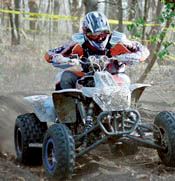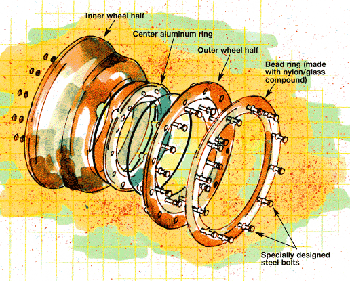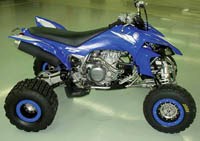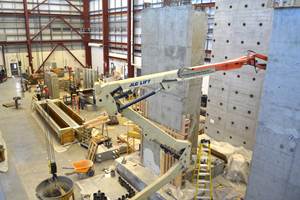Composite Wheels A First For ATV Racers
Tough, impact-resistant glass-/carbon-reinforced thermoplastic lasts longer and reduces unsprung weight for better handling.
|
Engineering Challenge: Develop a robust yet lightweight wheel for off-road and dirt-track racing vehicles, which can stand up to aerial jumps, high speeds and tight cornering. Design Solution: A multi-piece, injection molded, carbon-reinforced wheel that is tough and resilient and as much as 0.9 kg / 2 lb lighter than the aluminum wheels they replace. |
The wheel goes round and round — unless you've just landed a 30-ft high jump in a all-terrain vehicle (ATV) race, hit a rock, bent a rim and suffered a flat tire. The wheels used by off-road ATV racers take tremendous abuse, says Tom Darnell, founder and chief designer at HiPer Technology Inc. (Lawrence, Kan.), a high-performance composite part development firm and injection molder of composite wheels. An avid ATV racer himself, Darnell was tired of metal wheels that would bend out of shape or crack and break during races. "If you bend or damage a wheel, you have to throw the whole thing away — that was normal practice," he explains. And at $190 to $200 (USD) each, they're very expensive as well. "I wanted to design something better that would absorb energy and resist fatigue," he says.
Metal ATV wheels are two-piece constructions of aluminum or steel, welded together in the center, and typically about 250 mm to 300 mm (10 inches to 12 inches) in diameter. Darnell envisioned a lighter and much tougher composite alternative, at a similar or lower price, that would last longer under racing conditions. A former Ford Motor Co. automotive engineer, Darnell had worked with fascia systems, so he already was familiar with filled plastics and believed such materials were the answer. However, a composite wheel presented some definite challenges, because of high load inputs and demanding performance requirements. Off-road ATV wheels see more than 1,361 kg/3,000 lb of impulsive dynamic load at the rim edge in the vertical direction, and torque loads at the contact point of the hub can be as high as 1,000 ft/lb (the torque is reduced as you move outward from the center to the wheel edge).
DESIGN & MATERIAL SELECTION GO HAND-IN-HAND
Unlike its metal counterpart, a composite wheel could be designed to flex under load and spring back to shape, through millions of cycles. The design process involved not only defining part function and developing a prototype, but also identifying a high-elongation material that could flex without cracking and be inexpensive to manufacture using a high-volume process, such as injection molding.
Darnell designed two flared cylindrical wheel body halves, with the inner half deeper than the outer half, separated by an aluminum center ring and secured with one or two larger "bead lock" rings (depending on the wheel model) on the outer side. The components are through-bolted together with steel fasteners. The wheel's geometry was defined and modeled in SolidWorks 3D (SolidWorks Corp., Concord, Mass.). Finite element analysis (FEA) was done with COSMOS linear FEA software supplied by Structural Research & Analysis Corp. (SRAC, Los Angeles, Calif.).
Elongated "bathtub" ribs were designed around each bolt hole on the inner surface of the larger wheel body. "Those ribs transmit the torque from the fasteners out into the wheel tub and into the composite," explains Darnell. The bolts were custom-designed by Darnell to maximize the contact area under the bolt head and minimize point loads and stress risers, which can lead to cracks. The bolts are produced in China.
While selection of the optimum material for an application is always among the most critical and challenging phases of any composite product design, it was an unusually tricky task for Darnell. Available materials missed the mark. "I looked at filled plastics for more than a year," he recalls. "You either had really soft alloyed or base resins, with very high elongation but low strength, which couldn't absorb any compressive stress from fasteners, or you had very strong, rigid but brittle composites, like long glass/nylon compounds, that would shatter." At one point, he reports, a long-fiber glass compound loaded with toughening agents seemed to work, but its specific gravity was almost as high as magnesium, so there was no weight benefit.
GLASS/CARBON MIX MAKES THE GRADE
Eventually Darnell connected with DuPont Engineering Polymers' (Dearborn, Mich.) Paul Chang. Chang's group, in collaboration with HiPer, ultimately developed Zytel CDV805 as a pelletized injection molding compound. With synthetic polyamide 6/6, commonly known as nylon, as the base resin, the material incorporates short, chopped glass and PANEX 48K carbon fiber, the latter from Zoltek Corp. (St. Louis, Mo.). Carbon black filler and stabilizers are added to boost ultraviolet (UV) performance. "The glass fibers help us achieve a lower material cost, while the carbon's stiffness helps bear load and also creates an overall lower specific gravity," Darnell notes. (Bead lock rings are made from a glass-filled Zytel compound without carbon fiber.) "We had to have multidirectional strength, that is, isotropic properties, and we had a big challenge to get the fibers to lay in randomly — the carbon doesn't like to disperse," he continues. While exact fiber lengths and fiber/resin proportions remain under wraps, Darnell reveals that DuPont developed a
new patented fiber sizing recipe that enables its reactive nylon toughening additives in the resin to bond to the carbon filaments and, at the same time, enables tow bundle dispersion in the resin for optimum uniformity in reinforcing properties. Zytel CDV805 is now available on the open market for applications outside of HiPer's area of concentration, per an agreement with DuPont, says Darnell.
WATER, WALL THICKNESS AND KNIT LINES
While CDV805 fit the bill structurally, its handling and processability posed additional challenges. Nylon compounds tend to absorb water before processing — ambient water molecules in the air try to occupy cross-linking sites and can severely impact a large part's strength. To reduce moisture uptake, CDV805 pellets are shipped to HiPer from DuPont in hermetically sealed bags.
Further, initial tests showed that the material would shrink a whopping 13 percent during cooling, due to the high toughener load. For comparison, a 40 percent glass/nylon shrinks about 0.5 percent. Undeterred, Darnell simply made the assumption that the molded wheel could be machined to final dimensions, and he designed the cavity molds to produce a slightly oversized part. "It's easily machined," he explains. "In terms of the shrinkage, we don't care how much it moves, as long as it stays within a certain envelope."
Finally, part size and wall thickness were sticky wickets for HiPer's startup injection molding group. To meet the strength requirements for the company's 381-mm/15-inch wheel, the largest it offers, the design dictated a wall thickness of about 12.7 mm/0.500 inch. Considered a fairly thick-walled part in the industry, this wheel required an approximate 1.3 kg/2.5-lb shot of material. Large parts injection molded from fiber-filled compounds are prone to knit lines and pinhead voids, because the entrained fibers can change the dynamics of resin flow in the mold. Knit lines occur when material flow fronts meet and begin to cool before they can flow together and fully intermix. Fibers tend not to cross and bridge the border between the fronts, with the result that strength at the knit line can be reduced to that of the unfilled resin. Pinhead voids are caused by air or gasses trapped under fibers during part cool down and shrinkage. Both are highly undesirable in a highly loaded wheel part, as they can act as stress risers. "It's just like a metal casting," says Darnell. "You don't want any porosity because that's where cracks will begin."
TUNING AND TESTING
Darnell and HiPer's manufacturing team have worked for the past year to develop molding techniques that avoid these issues. Injection molding, using screw-and-barrel machines, occurs in a humidity-controlled room. Manufacturing process control, particularly aimed at proper heat management, is highly sophisticated and optimized in this case. The multi-cavity molds were designed and fabricated in-house by HiPer. "We can now routinely mold at [12.7 mm] 0.500-inch wall thickness without any voids or knit lines," Darnell maintains, adding, "We've tried to mold at [19.5 mm] 0.750-inch thick, and we can do it, but at this point it would be tough to do in production."
After demolding, the parts are trimmed to final dimension using a CNC milling machine supplied by Cincinnati Lamb (Hebron, Ky.) or one of several TRAK portable CNC machines that can be shuttled between production lines. TRAK mills are manufactured by Southwestern Industries Inc. (Rancho Dominguez, Calif.).
The success of the wheel design has been verified by extensive real-time testing, ranging from failure evaluation in various fixtures to actual vehicle trials to simply smashing the parts on the ground. "It's a very big struggle for a lot of composites companies to accurately prototype and model failure modes in materials. Even though we did the initial modeling, we still needed to take all the empirical testing data we could collect and put it back into the model, and try to get it to reproduce our observed results," Darnell continues. "We're at about 90 percent right now." Dynamic or nonlinear FEA modeling is still underway at several outside modeling shops, using different software approaches, including NASTRAN, to improve and perfect the wheel designs.
Test results reveal that cracking and crack propagation under load is the principle failure mechanism. Darnell wanted to ensure that even if cracking occurred under extreme stress, the wheel wouldn't fragment or shatter onto the racetrack, causing a hazard to other riders. "It's okay if the wheel cracks under high load — nothing is indestructible," he maintains. "For an aluminum wheel, failure is bending until a leak path is created, and it can't function. On our wheel, it's a crack, and our design together with the compound means we achieved our goal — our wheel doesn't shatter and fall apart."
AWARDING-WINNING DESIGN
The wheels then were tested against the National Tire and Wheel standard criteria for a Blunt Energy test (based on SAE J175, section 4). The test uses a fixture that orients the rim at 13° (±1°) from the vertical axis, so that a blunt weight, dropped from a specified height, impacts the highest point on the rim. A second test was the Rotary Fatigue test, defined by SAE J328, sections 4.0-4.3. This test determines the wheel's resistance to cracking and failure at the wheel center, the point at which most metal wheels fail in off-road use. The wheels are spun under load for 200,000 or more cycles, under a load moment of 235 ft/lb of torque and 203 ft/lb of side load. The test demonstrated that HiPer's molded ATV wheel is 2.7 times as resilient as 6061T6 aluminum, while weighing in 0.45 kg to 0.90 kg (1 lb to 2 lb) lighter than aluminum wheels, depending on the size. Lighter wheels mean that "unsprung weight" (the portion of the total vehicle weight that is not supported by the springs and shock absorbers in the suspension system) is lower, which translates to better road handling and control. Further, UV testing has shown that the wheels are environmentally stable for 30 years — better than most composite products. With its modular design, a wheel can be quickly disassembled in the field and a new tire mounted quickly, a bonus for race mechanics. At an average price of $175, the cost is less than competing metal wheels. The wheels grabbed the top award in the "Transportation" category in the annual product design competition sponsored by the Society of the Plastics Industry's Structural Plastics Division in 2002. And based on the product's performance to date, each HiPer wheel now comes with a two-year warranty.
In addition to ATV wheels, a market that's growing over 20 percent per year, HiPer now makes wheels for junior dragsters (scaled-down drag racers for youngsters), microsprint racecars and small motorcycles. When asked whether a composite HiPer wheel will ever be included on a production car or truck, Darnell answers in the negative. "Tire and wheel testing for passenger vehicles is extremely rigorous and costly. I see more likely growth into areas like utility and garden applications." Specifically, he's eyeing golf carts, which currently have steel wheels easily corroded by lawn chemicals. HiPer's carbon/nylon wheels, by contrast, are completely chemical resistant.
"I didn't set out to make a composite wheel in particular," Darnell concludes. "I just wanted to make high-performance composite parts that were well designed and performed well, at a good price."
Related Content
Composites end markets: Infrastructure and construction (2024)
Composites are increasingly used in applications like building facades, bridges, utility poles, wastewater treatment pipes, repair solutions and more.
Read MoreSGL Carbon carbon fiber enables German road bridge milestone
A 64-meter road bridge installed with carbon fiber reinforcement is said to feature a first in modern European bridge construction, in addition to reducing construction costs and CO2 emissions.
Read MoreKU researchers explore FRP materials for dams, levee reinforcement
To address aging infrastructure, a team of researchers at KU is conducting research into repairing and retrofitting 700-plus dams, levees and related structures nationwide using FRP materials.
Read MoreCCG FRP panels rehabilitate historic Northamption Street Bridge
High-strength, composite molded, prefabricated panels solve weight problems for the heavily-trafficked bridge, providing cantilever sidewalks for wider shared use paths.
Read MoreRead Next
VIDEO: High-volume processing for fiberglass components
Cannon Ergos, a company specializing in high-ton presses and equipment for composites fabrication and plastics processing, displayed automotive and industrial components at CAMX 2024.
Read More“Structured air” TPS safeguards composite structures
Powered by an 85% air/15% pure polyimide aerogel, Blueshift’s novel material system protects structures during transient thermal events from -200°C to beyond 2400°C for rockets, battery boxes and more.
Read MoreDeveloping bonded composite repair for ships, offshore units
Bureau Veritas and industry partners issue guidelines and pave the way for certification via StrengthBond Offshore project.
Read More

















.jpg;maxWidth=300;quality=90)







